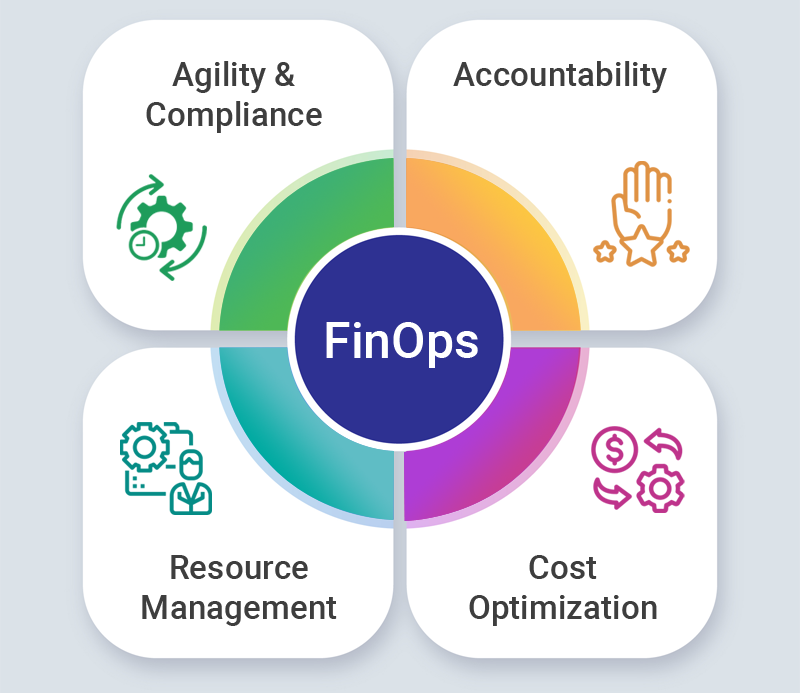A recent survey found that a significant portion of Cloud investment goes to waste. While the respondents admitted to their investments rising by 4% in 2023, wastage shot up 2% compared to the 2022 figure of 30%. That’s nearly one-third of their investments! And to top that, almost all respondents reported they were overshooting their budget by at least 13%.
Amid headwinds and mounting macroeconomic pressures, businesses can no longer blame Cloud opacity for dwindling ROI and rising wastage. As companies tighten their purse strings and scout for cost-saving avenues, optimizing Cloud spending is an area they must focus on.
Businesses must break down silos aggressively and develop a collaborative culture that promotes financial discipline and progress. But the question is how to do so without hampering prospects and affecting the bottom line.
FinOps can pare down wastage.
An emerging discipline, Cloud FinOps, can help businesses overcome the opacity and silos inherent to Cloud adoption by offering a framework to build a collaborative culture and disciplined ecosystem.
According to the FinOps Foundation Technical Advisory Council, “FinOps is an evolving cloud financial management discipline and cultural practice that enables organizations to get maximum business value by helping engineering, finance, technology, and business teams to collaborate on data-driven spending decisions (sic).”
FinOps, or Financial Operations, seek to optimize Cloud spending to help businesses manage infrastructure costs. FinOps provides a framework and a set of practices to enable collaboration, implement cost management strategies, and use technology to automate cost optimization. Through this trifecta, businesses gain visibility into their Cloud spending and control over costs to achieve better ROI.
What are the benefits of FinOps?
FinOps is a framework upon which businesses can develop their practices to generate optimum ROI by reducing costs and ushering in a cultural transition. Here are some more benefits FinOps offer to businesses:

Accountability
FinOps ushers in a culture of collaboration between finance, operations, and development teams. Such a collaboration breaks silos and helps them fix accountability on usage. This new data-driven culture brings transparency around Cloud costs and uses, enabling businesses to make more informed decisions about their strategy.
Cost Optimization
It provides real-time visibility into Cloud usage and spending to help businesses identify areas of inefficiency and eliminate unnecessary spending. Such visibility can optimize processes to save money and achieve better ROI.
Better Resource Management
The visibility offered by FinOps can help assess resource utilization, allowing them to pinpoint the areas of underutilization and overprovisioning. This way, businesses can optimize their usage and scale based on requirements.
Agility & Compliance
Better resource management results in agility as businesses can scale their infrastructure without incurring unnecessary costs. It enables them to respond more quickly to changing business needs while complying with industry regulations and security standards.
How does FinOps framework work?
As a data-driven approach to Cloud cost management, FinOps optimizes Cloud resource utilization by enabling active collaboration between finance, operations, and development teams and using automation tools and processes. Here’s a high-level overview of its working mechanism:

The Governance Framework
It begins by establishing a governance framework for Cloud resource management. The process includes defining policies, procedures, and best practices for managing Cloud costs and resources. It is followed by establishing roles and responsibilities for finance, operations, and development teams.
1. Visibility
To be effective, FinOps gains deep visibility into Cloud usage and spending. The process involves tracking and monitoring Cloud resource usage, analyzing cost data, and identifying areas of inefficiency and waste.
2. Assessment
FinOps is an iterative process requiring continuous assessment of the environment to find newer avenues of efficiency and cost-effectiveness. By evaluating the organizational financial processes, systems, and strategies, FinOps equips businesses to align financial operations with business objectives.
Some key markers of a thorough assessment process are:
- Cost Management: Key to identifying the areas of inefficiency
- Financial Data Analysis: Assessing financial data to identify trends, patterns, and anomalies.
- Process Efficiency: Assess financial processes, and identify bottlenecks and the areas requiring automation.
- Compliance and Risk Management: Ensuring compliance with relevant regulations and industry standards.
- Performance Metrics: Defining KPIs and metrics to measure the effectiveness of financial operations.
A robust FinOps model achieves the above goal by:
- Establishing Clear Objectives
- Gathering and Analyzing Cost Data
- Implementing Cost Allocation and Tagging
- Optimizing Resource Allocation
- Implementing Cost Control Policies
- Continuous Monitoring and Optimization
- Fostering Collaboration and Awareness
- Leveraging Automation and AI
- Continuous Review and Refining
3. Optimization
After identifying the areas of inefficiency and waste, FinOps sets about optimizing Cloud resource usage. This step involves implementing cost-saving measures, such as eliminating underutilized resources, right-sizing instances, and optimizing storage usage.
4. Automation with AI
The advent of AI has changed the technological landscape. Now, businesses can automate many manual tasks, freeing their human resources for tasks requiring creativity and analytical skills. FinOps leverages AI to:
Predict Costs
AI models can crunch large volumes of data in a few seconds to offer unparalleled insights. Businesses can leverage these insights to analyze historical cost data and usage patterns, which pave the path for forecasting Cloud costs. AI swiftly considers seasonality, workload variations, and pricing changes to provide near-accurate predictions.
Anomaly Detection
AI detects anomalous cost spikes or usage patterns and flags them. Such continuous monitoring allows organizations to take prompt action.
Resource Optimization
AI-powered optimization techniques analyze resource utilization patterns and suggest recommendations for optimizing resources. This process includes identifying underutilized instances, recommending right-sizing options, suggesting reserved instances or savings plans, and providing insights into cost-effective storage and network configurations.
Automated Cost Management
AI-based systems can automate various cost management tasks, such as implementing cost control policies, monitoring and alerting on cost thresholds, and enforcing resource utilization policies. This reduces manual effort and ensures continuous cost optimization based on predefined rules and AI-driven insights.
Advisory Engines
AI-powered advisory engines can suggest cost optimization strategies and actions based on historical data, industry best practices, and cost optimization models. These recommendations can help organizations make informed decisions on resource provisioning, purchasing options, workload placement, and overall cost management.
Intelligent Budgeting
AI models can assist in setting accurate and realistic budgets by considering historical spending patterns, business growth projections, and cost drivers. AI algorithms can provide recommendations on budget allocation across departments, projects, or teams based on their respective historical costs and future requirements.
Predictive Scaling
AI algorithms make predictions about future resource demands by analyzing workload patterns. This way, organizations can scale their resources to optimize costs while ensuring performance and availability.
Cost Trend Analysis
AI can analyze cost trends over time, identify cost-saving avenues, and highlight areas for optimization. Using these analytics, companies can make informed decisions on cost efficiency.
Cost Benchmarking
AI-powered systems can provide cost benchmarking analysis by comparing an organization’s Cloud costs with industry standards or similar organizations. This helps organizations gauge their cost efficiency and identify areas to optimize spending.
Continuous Optimization
As an iterative process, continuous optimization is critical. This step involves regular review and analysis of cost and usage data, tracing and identifying areas for improvement, and implementing changes based on needs.
Why is FinOps critical to governance?
The governance framework provided by FinOps ensures that resource utilization is in tune with organizational goals and priorities. Here’s how FinOps provides a governance framework:

Cost Allocation
By providing an optimum framework for allocating costs to the appropriate centers or business units, FinOps enables organizations to track and report on Cloud spending. This process ensures that cloud resources are used per organizational policies and budgets.
Resource Optimization
By eliminating underutilized or unnecessary resources, FinOps helps businesses to optimize resources. This way, companies can rest assured that their resources are used efficiently and effectively.
Security and Compliance
Amid a spate of breaches and security incidents, businesses need help to comply with the changes in the regulatory world. FinOps helps companies to adhere to evolving regulations by ensuring a secure configuration of resources and putting access controls in place to protect sensitive data. Such a robust security mechanism enables businesses to comply with industry regulations and security norms more quickly.
Auto scheduling and Trend-based Auto Optimizations
Any talk about FinOps is incomplete with its two critical components: auto-scheduling and trend-based auto-optimization. These two components are vital in streamlining processes, improving efficiency, and maximizing financial performance.
Auto Scheduling
It helps companies implement FinOps to automate the generation and management of schedules for financial processes. Key components include:
- Budgeting
- Forecasting
- Expense tracking
- Invoice processing
- Payment scheduling
A robust auto-scheduling component, for instance, automatically generates budgeting schedules outlining the key dates and milestones for preparing, reviewing, and finalizing the budget. It also sends reminders and notifications to stakeholders.
Trend-Based Auto Optimizations
It involves leveraging historical and real-time data to identify trends, patterns, and opportunities for optimization automatically. It includes identifying areas for cost reduction, revenue enhancement, cash flow management, and risk mitigation.
By analyzing trends and patterns, the system can make data-driven recommendations and automatically implement optimizations.
For instance, it can identify cost-saving opportunities by analyzing spending patterns and recommend actions like renegotiating contracts, consolidating vendors, or optimizing resource allocation.
Similarly, it can identify revenue growth opportunities by analyzing customer behavior and recommend targeted marketing strategies or pricing adjustments.
However, implementing auto-scheduling and trend-based auto optimizations requires advanced technologies like AI, ML, and data analytics. These technologies are critical to analyzing large volumes of financial data, detecting patterns, and generating actionable insights for optimization.
Conclusion
FinOps ensures that Cloud cost management syncs with organizational aspirations by catalyzing and cementing inter-department collaboration. Its data-driven approach provides continuous Cloud optimization through automation, ensuring businesses get high ROI on their investments.

Edited By Shafi Syed. June 5, 2023

